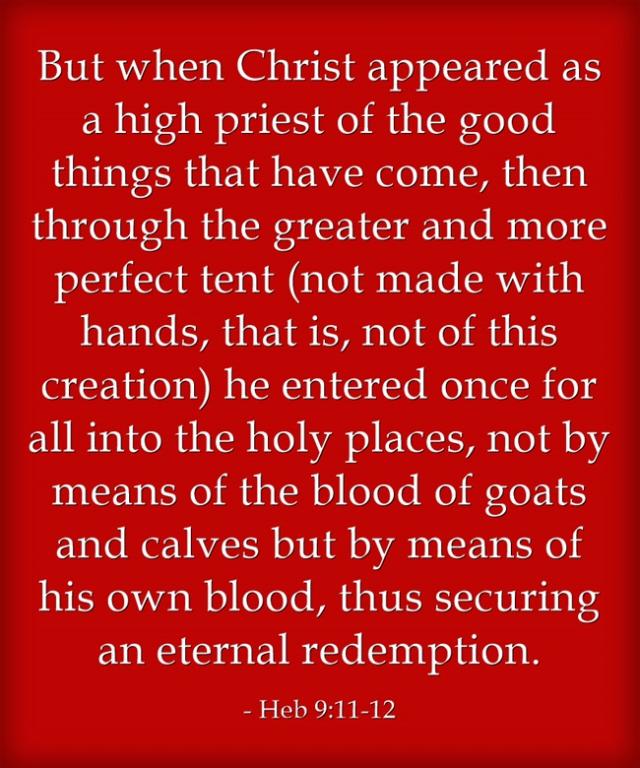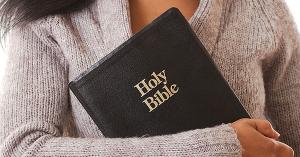Here is a Bible study, commentary, and summary of Hebrews chapter nine.
Hebrews 9:2-3 “For a tent was prepared, the first section, in which were the lampstand and the table and the bread of the Presence. It is called the Holy Place. Behind the second curtain was a second section called the Most Holy Place.”
When the high priest entered into the Holy Place and that was only once a year, he saw “the golden altar of incense and the ark of the covenant covered on all sides with gold, in which were a golden urn holding the manna, and Aaron’s staff that budded, and the tablets of the covenant. Above it were the cherubim of glory overshadowing the mercy seat. Of these things we cannot now speak in detail” (Heb 9:4-5). Aaron’s staff represented authority, the tables of stone the law, and the manna, God’s faithful provisions but to go behind the second curtain and that was a most sacred thing.
Why was the curtain separating the Holy Place from the rest of the temple?
Why were there two curtains?
Why is it called the “Most Holy Place?”
Hebrews 9:6-7 “These preparations having thus been made, the priests go regularly into the first section, performing their ritual duties, but into the second only the high priest goes, and he but once a year, and not without taking blood, which he offers for himself and for the unintentional sins of the people.”
Not every priest could go into the Holy Place. It was only permissible for the high priest and only on the Day of Atonement, which was a day of afflicting oneself by fasting. It’s interesting that the high priest would be fasting and only then was he permitted to enter but never without taking blood in with him but “the Holy Spirit indicates that the way into the holy places is not yet opened as long as the first section is still standing (which is symbolic for the present age)” (Heb 9:8-9a) but even the “gifts and sacrifices are offered that cannot perfect the conscience of the worshiper” (Heb 9:9).
Why can’t “gifts and sacrifices” perfect the conscience of the worshiper?
Why was there a commanded fast day on a feast day or holy day?
What did the fast have to do with entering into the Holy Place?
Hebrews 9:11-12 “But when Christ appeared as a high priest of the good things that have come, then through the greater and more perfect tent (not made with hands, that is, not of this creation) he entered once for all into the holy places, not by means of the blood of goats and calves but by means of his own blood, thus securing an eternal redemption.”
It was crucial that Jesus entered into the holy places with His own blood since “the blood of goats and bulls, and the sprinkling of defiled persons with the ashes of a heifer, sanctify for the purification of the flesh, how much more will the blood of Christ, who through the eternal Spirit offered himself without blemish to God, purify our conscience from dead works to serve the living God” (Heb 9:13-14). That is exactly why Jesus “is the mediator of a new covenant, so that those who are called may receive the promised eternal inheritance, since a death has occurred that redeems them from the transgressions committed under the first covenant” (Heb 9:15). That can cleanse even the conscience of the worshiper, unlike in the old sacrificial system.
What does the word “secure” as in our eternal redemption mean?
Why did the blood need to brought into the Most Holy Place?
Does Jesus ever have to enter the temple of heaven again with His own blood?
Do you think Jesus’ literal blood is still in heaven?
Hebrews 9:24-25 “For Christ has entered, not into holy places made with hands, which are copies of the true things, but into heaven itself, now to appear in the presence of God on our behalf. Nor was it to offer himself repeatedly, as the high priest enters the holy places every year with blood not his own.”
Jesus had to enter in the Holy Place only once, not once a year as on the Day of Atonement, but once for all time. His atonement was sufficient for all who believe and efficient to secure their eternal redemption. If He needed to enter heaven again and again with His own blood, “then he would have had to suffer repeatedly since the foundation of the world. But as it is, he has appeared once for all at the end of the ages to put away sin by the sacrifice of himself” (Heb 9:26).
Can Jesus blood cover every sin?
Why did Jesus have to enter heaven with His own blood?
Is Jesus’ blood enough to secure your eternal redemption?
Hebrews 9:27-28 “And just as it is appointed for man to die once, and after that comes judgment, so Christ, having been offered once to bear the sins of many, will appear a second time, not to deal with sin but to save those who are eagerly waiting for him.”
Everyone has a decision to make. Jesus puts it like this; “Whoever believes in the Son has eternal life; whoever does not obey the Son shall not see life, but the wrath of God remains on him” (John 3:36). Do you realize that He entered into the Most Holy Place with His own blood just for you, however it is sufficient to save you only if you chose to believe; it is likewise sufficient to condemn you if you reject it.
Summary
The significance of the Day of Atonement is not lost on the fact that it represents our being “at one” with God since before it was impossible (Isaiah 59:2). Jesus reconciled us back to God and has redeemed us with His own blood, entering the heavenly temple with His own blood, on behalf of all who trust in Him, and then they are secure in their eternal redemption. Can you think of any better reason for calling the gospel, the “good news?”
Article by Jack Wellman
Jack Wellman is Pastor of the Mulvane Brethren Church in Mulvane Kansas. Jack is also the Senior Writer at What Christians Want To Know whose mission is to equip, encourage, and energize Christians and to address questions about the believer’s daily walk with God and the Bible. You can follow Jack on Google Plus or check out his book Teaching Children the Gospel available on Amazon.
















